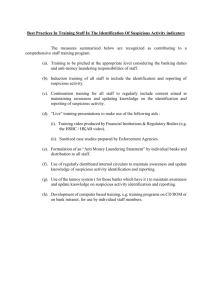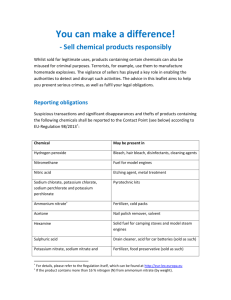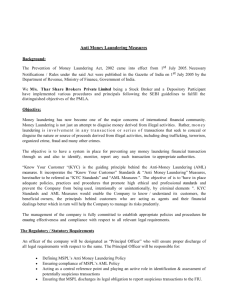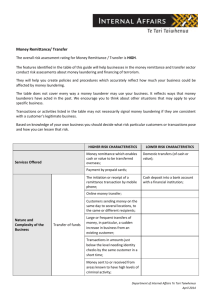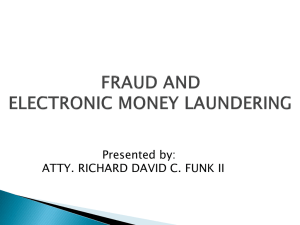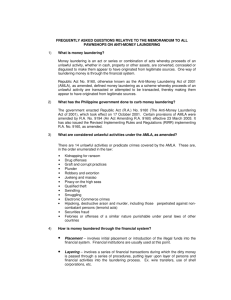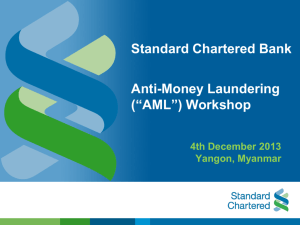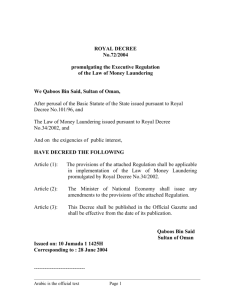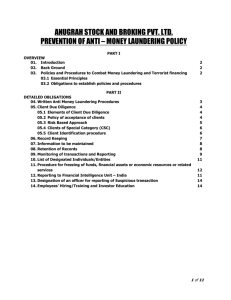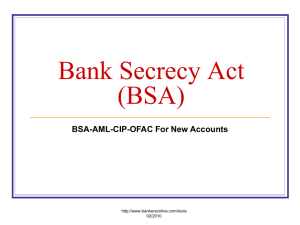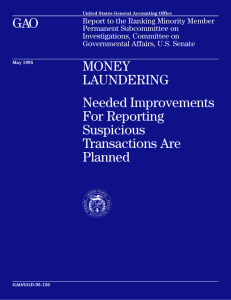Policies and Procedures to combat money
advertisement
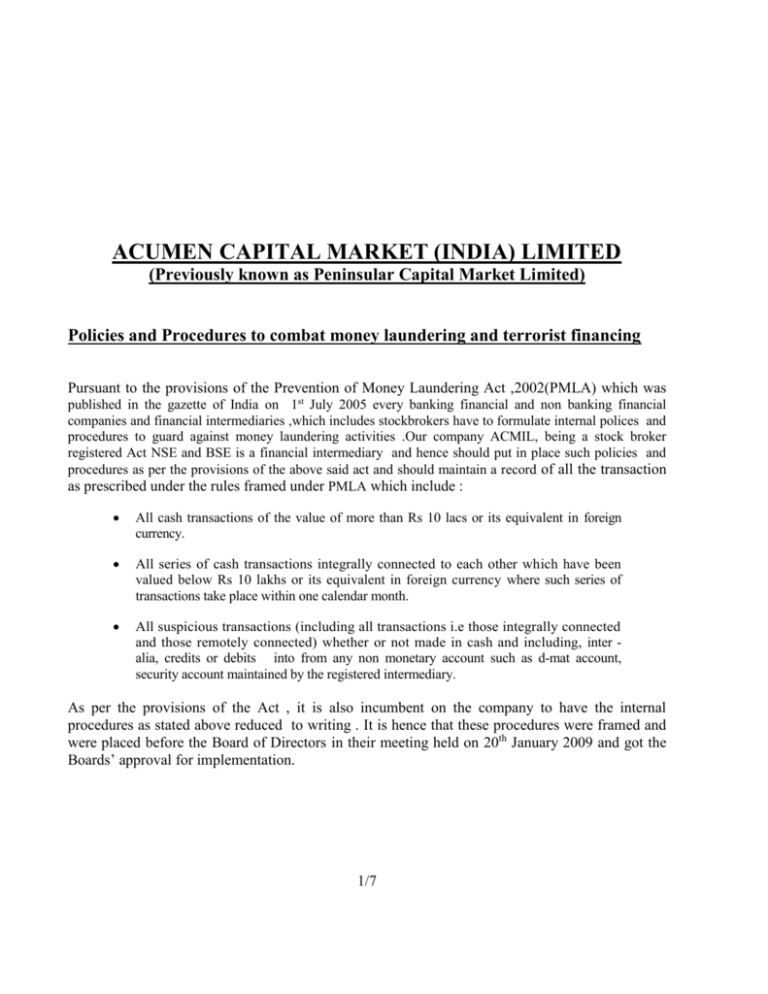
ACUMEN CAPITAL MARKET (INDIA) LIMITED (Previously known as Peninsular Capital Market Limited) Policies and Procedures to combat money laundering and terrorist financing Pursuant to the provisions of the Prevention of Money Laundering Act ,2002(PMLA) which was published in the gazette of India on 1st July 2005 every banking financial and non banking financial companies and financial intermediaries ,which includes stockbrokers have to formulate internal polices and procedures to guard against money laundering activities .Our company ACMIL, being a stock broker registered Act NSE and BSE is a financial intermediary and hence should put in place such policies and procedures as per the provisions of the above said act and should maintain a record of all the transaction as prescribed under the rules framed under PMLA which include : All cash transactions of the value of more than Rs 10 lacs or its equivalent in foreign currency. All series of cash transactions integrally connected to each other which have been valued below Rs 10 lakhs or its equivalent in foreign currency where such series of transactions take place within one calendar month. All suspicious transactions (including all transactions i.e those integrally connected and those remotely connected) whether or not made in cash and including, inter alia, credits or debits into from any non monetary account such as d-mat account, security account maintained by the registered intermediary. As per the provisions of the Act , it is also incumbent on the company to have the internal procedures as stated above reduced to writing . It is hence that these procedures were framed and were placed before the Board of Directors in their meeting held on 20th January 2009 and got the Boards’ approval for implementation. 1/7 Procedures As per the guidelines issued under the provisions of the PMLA each stock broker should have procedures for Client Due Diligence process which include (a) (b) (c) Policy for acceptance of client Procedure for identifying clients and Transactions monitoring and reporting especially suspicious transaction reporting. 1.1 Client Due Diligence Process-General_ This consist of the following 1.1.1 Ensure that KYC Norms are strictly followed and all the information provided in the KYC form are obtained and filled up. 1.1.2 Obtain sufficient information in order to identify persons who beneficiary own or control securities account. Whenever it is apparent that the securities acquired acquired or maintained through an account are beneficially owned by a party other than the client, that party should be identified using client identification and verification procedures. The beneficial owner is the natural person or persons who ultimately own, control or influence a client and/or persons on whose behalf a transaction is being conducted. It also incorporates those persons who exercise ultimate effective control over a legal person or arrangement. 1.1.3 Verify the customer’s identity using reliable, independent source documents, data or information. 1.1.4 Identify beneficial ownership and control, i.e. determine which individual(s) ultimately own(s) or control(s) the customer and/or the person on whose behalf a transaction is being conducted. 1.1.5 Verify the identity of the beneficial owner of the customer and/or the person on whose behalf a transaction is being conducted, corroborating the information provided in relation to (c); and 1.1.6 Conduct ongoing due diligence and scrutiny, i.e. perform ongoing scrutiny of the transactions and account throughout the course of the business relationship to ensure that the transactions being conducted are consistent with the registered intermediary’s knowledge of the customer, its business and risk profile, taking into account, where necessary, the customer’s source of funds 2/7 1.2 Policy for Acceptance of Clients The policy is to enable customer due diligence on a risk sensitive basis depending on the type of customer business relationships or transactions. Accordingly the following safeguards are to be followed while accepting the clients. 1.2.1 No account is opened in a fictitious / benami name or on an anonymous basis 1.2.2 Risk Perception : Based on clients location, nature of business activity, trading turnover, manner of making payment for transactions undertaken, clients should be classified into low, medium and high risk category. Though as per guidelines issued by SEBI and practiced by the company this system of making payments to and for receiving payments from, clients is through banking channels only and in the manner specified, the following points are to be ensured. (a) No payment in cash is either accepted or made to the client. (b) Display this clearly in the notice board and as part of ‘Do’s’ and ‘Don’ts’ issued in writing to the clients as part of client registration. (c) Discourage payment by clients by DD. In exceptional cases DD’s may be accepted if the same is supported by a letter from the client to the effect that the DD is from the banking account ,proof of which is provided to the company . (d) Ensure that the internal control policy in this regard are strictly followed 1.2.3 Ensure that no account is opened where the intermediary is unable to apply appropriate clients due diligence measures / KYC policies. Such cases are where: (a) It is not possible to ascertain the identity of the client (b) Information provided is suspected to be non genuine. (c) It appears that client’s dues not co-operate by providing full and complete information 1.2.4 Except in cases where the client and the person who acts for the client are identified or where the company has knowledge about the client and or the person acting for the client, no person shall be permitted to act for and on behalf of a client and where such permission is given ensure the following. 1. Ascertain that the circumstances which warrant a person to act on behalf of a client is genuine .(Such as prolonged illness (where clearly proved) long absence from station or other genuine in capabilities). 2. There is proper authorization in favor of the person acting on behalf of the client (Proper POA together with the photograph of the client and the person acting on behalf of the client affixed on POA, which is notarized). 3. In what manner account should be operated, what limits can be provided the right &responsibilities of the client and the POA holder, etc., are clearly mandated in POA. 3/7 1.2.5 Ensure that identity of the client does not match with any person having known criminal background or is not banned in any other manner. 1.2.6. The following are considered as special category clients and in respect of all them utmost care should be taken to clearly identify the client before the account is opened. The category of clients referred to herein are: a. Non resident clients b. High networth clients, c. Trust, Charities, NGOs and organizations receiving donations d. Companies having close family shareholdings or beneficial ownership e. Politically exposed persons (PEP) of foreign origin f. Current / Former Head of State, Current or Former Senior High profile politicians and connected persons) g. Companies offering foreign exchange offerings 1.2.7 As far as possible reference and confidential report about the genuinity of the client should be obtained from the client’s bankers in respect of all cases other than (e),(g),(h),(i) and (j) 1.2.8 In respect of those listed as (e),(g),(h),(i) and (j) avoid dealing with them and do not open any account for them. 1.2.9 As far as possible and except where it is unambiguously made known that the voluntary donations and other receipts of the Trust/Charitable Organizations/NGO are from genuine sources and not from unidentified or fictitious person, no account of trust/charitable organization/NGO should be opened. 2. Client Identification Procedure : 2.1 Ensure the ‘Know your Client’ (KYC) policy spelt out in the internal control policy is strictly carried out at different stages i.e. While establishing the intermediary - client relationship, while carrying out transactions for the client or when there arise has doubts regarding the veracity or the adequacy of previously obtained client identification data. 2.2 Ensure that the client is identified by using reliable sources including documents / information. Also obtain adequate information to satisfactorily establish the identity of each new client and the purpose of the intended nature of the relationship. 2.3 Ensure that each original document is seen prior to acceptance of a copy. 2.4 Failure by prospective client to provide satisfactory evidence of identity should be noted and reported to the higher authority within the company. 2.5 Ensure to maintain continuous familiarity and follow-up where inconsistencies in the information provided by the client are noticed. 4/7 3. Record Keeping 3.1 Ensure compliance with the record keeping requirements contained in the SEBI Act, 1992, Rules and Regulations made there-under, PML Act, 2002 as well as other relevant legislation, Rules, Regulations, Exchange Bye -laws and Circulars. 3.2 Ensure that such records as are sufficient to permit reconstruction of individual transactions (including the amounts and types of currencies involved, if any) so as to provide, if necessary, evidence for prosecution of criminal behavior are maintained 3.3 Should there be any suspected drug related or other laundered money or terrorist property, the competent investigating authorities would need to trace through the audit trail for reconstructing a financial profile of the suspect account. To enable this reconstruction, it is ensure that the following information as regards the accounts of the customers is retained in order to maintain a satisfactory audit trail. (a) the beneficial owner of the account; (b) the volume of the funds flowing through the account; and (c) for selected transactions (d) the origin of the funds. (e) the form in which the funds were offered or withdrawn, e.g. cash, cheques, etc.; (f) the identity of the person undertaking the transaction; (g) the destination of the funds; (h) the form of instruction and authority. 3.4 Ensure that all customer and transaction records and information are available on a timely basis to the competent investigating authorities. ( e.g. customer identification, account files, and business correspondence, for periods which may exceed that required under the SEBI Act, Rules and Regulations framed there-under PMLA 2002, other relevant legislations, Rules and Regulations or Exchange bye-laws or circulars. ) 4. Retention of Records 4.1 The following document retention procedure should be observed: (a) All necessary records on transactions, should be period of 10 years (b) 4.2 maintained at least for a minimum Records on customer identification (e.g. copies or records of official identification documents like passports, identity cards, driving licenses or similar documents), account files and business correspondence should also be kept for the same period. In situations where the records relate to on-going investigations or transactions which have been the subject of a suspicious transaction reporting, they should be retained until it is confirmed that the case has been closed. 5/7 5. Monitoring of transactions 5.1 5.2 5.3 Regular monitoring of transactions is vital for ensuring effectiveness of the Anti MoneyLaundering procedures. To achieve this, watch periodically the normal activity of the client so that deviations in transactions / activities are identified and enquired with the client. Ensure that transaction of suspicious nature or any other transaction notified under section 12 of the act is reported to the appropriate legal authority. Suspicious transactions should also be regularly reported to the higher authorities / head of the department in the Company. Ensure that random examination of a selected transactions undertaken by clients are carried out in order to comment on their nature i.e. whether they are the suspicious transactions or not. 6. Suspicious Transaction Monitoring & Reporting 6.1 Ensure to take appropriate steps to enable suspicious transactions to be recognized and report suspicious transactions. A list of circumstances which may be in the nature of suspicious transactions is given below. This list is only illustrative and whether a particular transaction is suspicious or not will depend upon the background, details of the transactions and other facts and circumstances: a) Clients whose identity verification seems difficult or clients appears not to cooperate b) Asset management services for clients where the source of the funds is not clear or not in keeping with clients apparent standing /business activity; c) Clients in high-risk jurisdictions or clients introduced by banks or affiliates or their clients based in high risk jurisdictions; d) Substantial increases in business without apparent cause; e) Unusually large cash deposits made by an individual or business; f) Clients transferring large sums of money to or from overseas locations with instructions for payment in cash; g) Transfer of investment proceeds to apparently unrelated third parties; h) Unusual transactions by CSCs and businesses undertaken by shell corporations, offshore banks /financial services, businesses reported to be in the nature of export-import of small items. 6.2 Any suspicious transaction should be immediately notified to the Money Laundering Control Officer or any other designated officer within the Company. The notification may be done in the form of a detailed report with specific reference to the clients, transactions and the nature reason for suspicion etc. It should however, it should be ensured that there is continuity in dealing with the client as normal until told otherwise and the client should not be told of the report/suspicion. In exceptional circumstances, consent may not be given to continue to operate the account, and transactions may be suspended, in one or more jurisdictions concerned in the transaction, or other action taken. 6/7 7. Designation of an officer for reporting of suspicious transactions 7.1 The principal officer already appointed for the purpose should act as a central reference point in facilitating onward reporting of suspicious transactions and for playing an active role in the identification and assessment of potentially suspicious transactions. 8. High standards in hiring policies and training with respect to anti-money laundering 8.1. Ensure that adequate screening procedures are in place to ensure high standards when hiring employees. Key positions within the own organization structure should be identified having regard to the risk of money laundering and terrorist financing and the size of their business and ensure that the employees taking up such key positions are suitable and competent to perform their duties. Provide proper antimony laundering and anti-terrorist financing training to their staff members. By the order of the Board. 7/7
